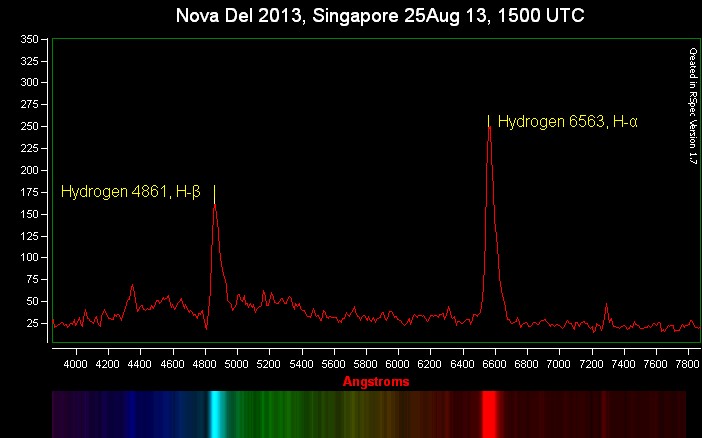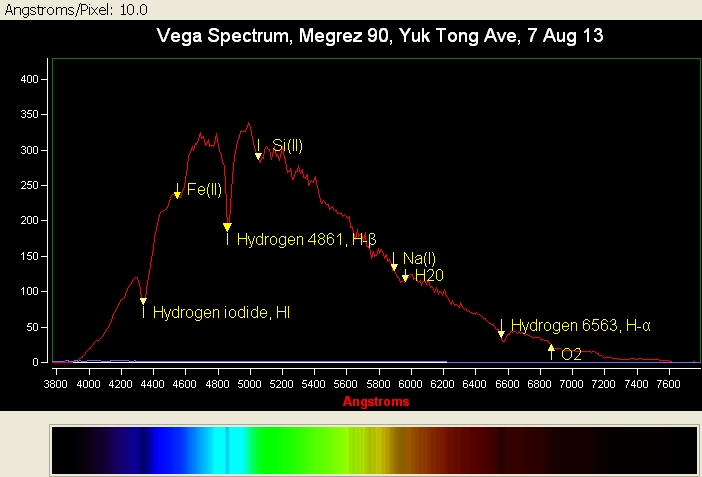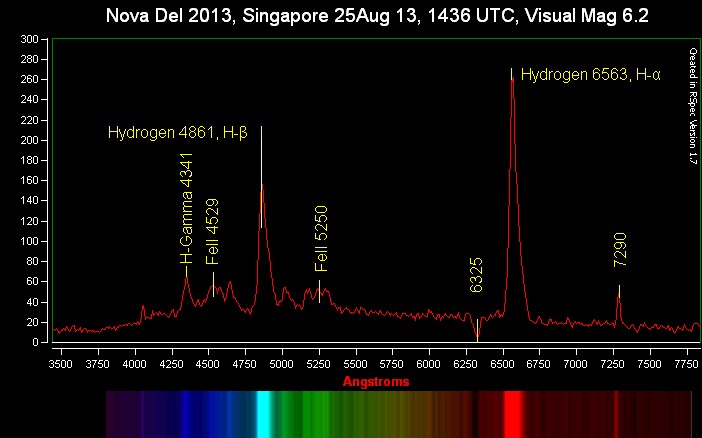Comments from Steve Shore :
Francois asked that I bore you all with some explanation of what's
happening in these data and perhaps to give you all some idea of what
the physical picture is. It's a pleasure, also because it's a chance
to say thank you to all of you for this amazing, invaluable effort.
Once the smoke clears (well, after possible dust formation?), we'll
have a chance to work through all of this for the eventual complete
analyses. You're all involved with that.
First, this is a stage not often accessed in the optical, even less in
the ultraviolet. In the first stage, after the explosion (that we
don't see), the ejected outer layer of the white dwarf expand
hypersonically and cool. Two things. First, this is a mixture of the
stuff that was accreted on the WD during the pre-nova stage, when it
sits inside an accretion disk from the companion and like a garbage
disposal just accumulates the stuff. Once a sufficient pileup occurs,
the compressed layer can initiate nuclear reactions and explode (well,
this is the surface, not the center, so there's nothing to constrain
the event). BUT there's a question even here. Theignition of the
nuclear fuel is like a flame, in fact physically it's very close, and
propagates like a flame through the envelope. This, in turn, provokes
a buoyant mixing (to avoid the word "boiling" but it's a similar thing)
that also dredges material from deeper layers. A major uncertainty, of
almost cosmological importance, is how much of that mixed matter is
blown off and whether the WD mass increases or decreases. But that's
for another time.
For this stage, the explosion throws the gas off like a shell but with
a catch, the velocity depends on radius because the range of velocities
is ballistic and within an interval from the escape velocity to
whatever can be reached by the energy of the explosion. So you will
see velocities up to thousands of km/s. On this, a word of caution.
I'll always, in any of these notes, emphasize that what you see is NOT
the whole story. The ejecta are not completely transparent at all
wavelengths and you see to different depths of this fog -- just like a
fog -- depending on whether you're in the lines, continuum, the optical
or UV or IR -- in other words, a radiographic image of a human is
similar. You see to the depth from which the light can escape to you,
the surface -- the "photosphere" to those who want to be technical --
is wavelength dependent.
The same with the velocities. You see different line profiles on, for
instance, each Balmer line. Since the sequence from H-alpha to beta
and so on. is also one of intrinsic opacity (strength) you see deeper
in H-gamma than H-alpha and the line is formed mainly ("weighted
toward") the inner ejecta. So the combined line profiles, viewed in
velocity, are the probe -- tomorgraphy -- of the ejecta. With this you
can look for structure, dynamics, even variable abundances. The trick
is following the seqeunces and seeing how each part of the spectrum
develops. The Fe lines appear because the UV is opaque and the
absorption at high energy excited the optical (low energy) lines. The
same for the He and Balmer lines. In all cases, the classes (Fe, He/N)
are not anything but descritpicve of this stage.
The spectra you all got last night were from the fireball, the initial
stage of the expansion that is hard to catch. Now you'll see the next
pass, as the ejecta start to recombine and turn into a dense "fog".
Then, as they thin out (weeks from now, likely) the emission will
appear again but in the first stage the lines pass from ionized and He
and H to those of more easily ionzed heavy metals that would have been
too ionized to observe in the fireball.
I hope tis helps. It's just the star, if there's anything anyone would
like to see or if anyone has questions or comments, youknow I'm always
online (
shore@df.unipi.it) even at the risk of filling all of our
mailboxes.
steve



![good-job [smilie=good-job.gif]](./images/smilies/good-job.gif) Good job! Thanks for sharing your methods and results!
Good job! Thanks for sharing your methods and results!![admire [smilie=admire.gif]](./images/smilies/admire.gif)
![cool [smilie=cool.gif]](./images/smilies/cool.gif)
![bye2 [smilie=bye2.gif]](./images/smilies/bye2.gif)
